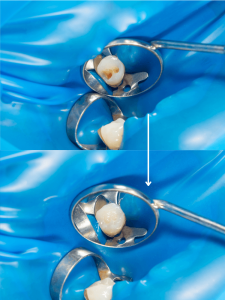The dental sealant is a flowable, opaque, or transparent composite that penetrates the grooves and is cured. It performs its protective role only if it is applied correctly. If the tooth is thoroughly cleaned, the enamel is etched precisely and if it is possible to ensure a job free from contamination of saliva.
Among the sites at the greatest risk of caries are the grooves between the cusps of the teeth, especially on the molars, where the toothbrush cannot eliminate the plaque that accumulates there. To overcome this risk, when necessary, as soon as the tooth has erupted enough to allow correct intervention, a groove sealing can be performed.

Do Sealants Cause Cavities?
The dangers of using dental sealants would be minor. Sealants are made without the use of any harmful products or agents. Furthermore, when the sealant is placed correctly, there is no known cavity formation under the sealant. The sealer would have halted the advancement of slight deterioration that existed before application in certain circumstances.
What is The Difference Between A Filling And A Sealant?
In the case of the filling, also known as a dental filling, it must be said that this is the most recommended and effective solution for solving dental caries. This intervention consists of a scraping of the decayed area. Later, the gap is filled through different materials, resin or composite being some of these options that are in greater demand today. It is a very straightforward and painless intervention carried out in just one session and lasts approximately fifteen minutes.
On the other hand, it is time to know the main peculiarities of applying a dental sealant since, in this way, we will be able to understand the differences between both concepts. In this sense, we have to know that dental sealants protect against tooth decay, so the main difference is that this intervention is carried out on healthy teeth, which does not happen if we opt for a filling. Regarding the intervention, we can say that we are facing one of the simplest treatments that we can find within the dentistry sector and in which a plastic coating is placed on the upper face of the tooth, which will make it possible to protect the piece from both the acid that causes tooth decay and bacterial plaque, being a preventive element that will be very useful and that can be used both in children and adults.

What Are the Three Types of Sealant Currently Available?
- Silver and mercury amalgams
Silver amalgam and mercury are known as “amalgams metal “, although composed of copper, tin, silver, and mercury. Dentists have been using them for a long time since they are sturdy and lasting, as well as the most cost-effective solution.
- Ceramic dental sealants
The dental sealants ceramic are made primarily of porcelain. They’re an excellent low-profile alternative, and they’re stain-resistant as well as tooth-coloured. The drawbacks to ceramic dental sealants are that they are more fragile than resins, and they are also almost as costly as their gold counterparts.
- Glass ionomer dental sealants
The last type of sealant is resin or glass ionomer sealants. They are made of fluoroaluminosilicate and acrylic, a constituent of glass. They are also used in milk teeth. Weaker than composite resin, glass ionomer dental sealants can last about five years and do not resemble the colour of your teeth.
What Material is Used For Dental Sealant?
Various materials are used for dental sealants, the most prevalent being silver and mercury, ceramic, glass ionomer, and even gold. Choose the best sealant as per the recommendation of your dentist.
We can provide your teeth with lasting protection at River Square Family Dentistry, with dental sealants in Rochester Hills, Michigan. Dr. Gehan Girgis is pleased to provide patients with dental sealants to prevent cavities in your molars and premolars.


0 comments on “What Are Dental Sealants?”